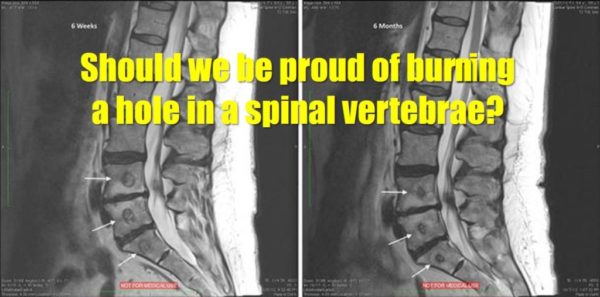We Should Never Be Proud of MRIs That Show Holes Burned in Patient’s Bodies…

©Regenexx
A new study was recently published on a new treatment for back pain due to degenerative discs. Ordinarily, I would be excited, as what’s not to like about another treatment option for back-pain patients. However, the problem with this one is that it works by blasting a hole in the vertebrae? Yep, you heard that right. Let me explain why I’m not a fan.
What Is RFA and Why Do I Now Think That It’s a Dumb Idea?
RFA stands for radiofrequency ablation. This means that a doctor places a radiofrequency (RF) probe that looks like a thick needle into the area and ablates or kills off tissue. This works by the tip of the probe emitting an RF signal that’s designed to generate heat. Usually, RFA is used to kill off nerves that are causing pain or are carrying bad signals, like in the case of a heart arrhythmia.
Why is this a bad idea? RFA is destructive. That means it works by killing tissue. Given that we now have multiple options like platelet rich plasma, advanced platelet lysates, cytokine-enriched serums, ECM products, and stem cell therapies that work by healing or rebuilding tissue, why would we want to kill tissue?
What Are Modic Changes?
Modic changes are the bright and dark areas found in the vertebrae, adjacent to the discs, on MRI in patients who have chronic low-back pain. They are signs that the bone isn’t healthy and are thought to happen because the disc has lost its ability as a shock absorber and is transferring too much energy to the bones. Hence, in older patients, you get more wear and tear than repair, and that causes Modic changes.
As we’ll see below, the authors of the new study believed that if they ablated the nerve supply of the bone, they could help patients with back pain that was being caused by the Modic changes.
The New Research
The new study is a high-level randomized controlled trial, or RCT. The authors used a specialized RF probe in patients who had pain due to degenerative disc disease. They inserted these into the vertebrae to kill off a nerve that they felt could be causing pain from damaged vertebrae. The good news is that this seemed to work to help the low-back pain. The bad news is that as the MRIs above show, they had to burn a hole in the vertebrae to do it. In fact, the authors seemed proud that there was still a sizable hole in the vertebrae months after the procedure!
What Are the Ethics of Burning Holes in Patients’ Bodies in the Age of Regenerative Medicine?
When RFA was all we had, it was a great tool. We used it in our practice to help patients with chronic neck pain due to damaged facet joints. In fact, in many ways it was revolutionary. However, it has several dark sides. One is obvious: you’re destroying tissue. In fact, the RFA docs used to love to place their probes in chicken breasts and use them to cook them from the inside! The second is not as obvious: when the pain returns in these patients because the nerve grows back, it returns with a vengeance. In fact, all of the RFA neck-pain patients we used to have got more and more brittle over time. Meaning that they would get worse and worse with each passing RFA session. I could take away their pain, often for months and occasionally 1–2 years, but with each treatment, they looked less and not more healthy.
We’ve since moved on from RFA and abandoned it as old 20th-century tech that’s not good for our patients. It’s been replaced with regenerative medicine solutions. That just makes common sense.
However, in a world where we know that orthobiologics, like PRP and stem cells, can regenerate and heal bone, what are the ethics of burning a sizable hole in a bone to kill a nerve? Is that treatment approach ethical just because a patient’s insurance company is more likely to cover an RFA treatment? Why not just inject an orthobiologic into the vertebrae?
The upshot? We shouldn’t be proud of using RF probes to burn holes in patients big enough to be observed on MRIs. In fact, we should be embarrassed by the lack of imagination that these treatments now represent in a world where regenerative therapies are becoming commonplace. As physicians, we should be telling the companies trying to make big bucks with the next RFA device, “Thanks, but no thanks. I can no longer justify burning big holes in my patients.”

NOTE: This blog post provides general information to help the reader better understand regenerative medicine, musculoskeletal health, and related subjects. All content provided in this blog, website, or any linked materials, including text, graphics, images, patient profiles, outcomes, and information, are not intended and should not be considered or used as a substitute for medical advice, diagnosis, or treatment. Please always consult with a professional and certified healthcare provider to discuss if a treatment is right for you.
